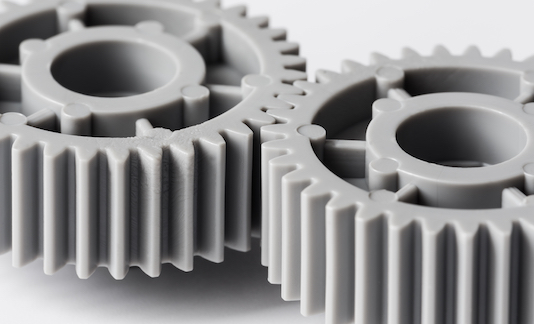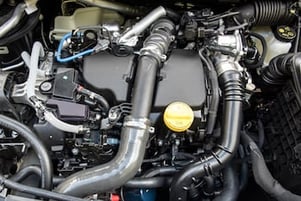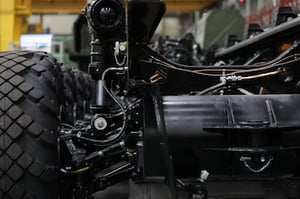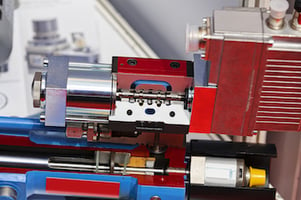
The demands of part design optimization can sometimes exceed the capabilities of standard polyamide or polyester compounds. In such instances ultra-high performance polymers such as PEEK, PPS, and LCP are often deemed the necessary solution. While in most cases these ultra-polymers are a robust material solution, they are also expensive and, more often than not, over engineered.
Alternatively, manufacturers who choose cross-linked engineering thermoplastic materials over these ultra-polymers can realize cost savings up to 40% — without compromising part performance. Cross-linkable PA 6, PA 66, PPA, and PBT compounds are readily molded on standard processing equipment and, once cross-linked, are proven solutions for meeting demanding requirements.
Are cross-linkable thermoplastics right for your application?
A cross-link is a bond that holds — or links — polymer chains together. In relation to thermoplastics, the goal of cross-linking is to interconnect long-chain molecules through covalent bonding in order to improve mechanical, thermal, electrical, and chemical performance. Typically, cross-linking is initiated either through e-beam radiation (irradiation) or chemical agents.
Teknor Apex supplies cross-linkable compounds in pellet form for processing on standard thermoplastic injection molding equipment. Molded parts are exposed to e-beam radiation, and a three-dimensional molecular network is formed within each part. The cross-linked parts remain unchanged in terms of size and appearance, but part performance is significantly improved.
Polyamide and other polyester compounds are semi-crystalline polymers. For most Polyamide 6 and 66 compounds the typical crystalline content after molding is in the 30-50% range, depending on a number of factors. The remaining 50-70% is amorphous content, which has a limiting/adverse effect on various properties of the materials.
Cross-linking such semi-crystalline polymers creates a three-dimensional network, as explained above, binding the polymer chains together predominantly in the amorphous region of the material. Hence the gel rate after cross-linking can be increased to 70-80% for reinforced thermoplastics, and 60-70% for unreinforced materials — i.e. nearly full cross-linking of the amorphous content.
Thus, cross-linking standard engineering plastics leads to significant improvements in several attributes:
Additionally, these materials can be molded on standard injection molding machines with standard processing guidelines and procedures. The cross-linking reaction is triggered only via secondary irradiation process and does not affect the molding step. Depending on the material selected and the application, these benefits can translate to a cost savings of up to 40% over expensive ultra-high performance resins.
Cross-linking is highly technical, and the process isn’t always easily understood. However, results speak volumes as to its viability. Teknor Apex has helped manufacturers across industries resolve complex issues by introducing cross-linked engineering thermoplastics, as summarized in these success stories:
 Application: Water pump gears
Application: Water pump gears
Solution Sought: Replacement for powder metal to reduce weight and cost
Key Application Requirements:
Teknor Solution: V-Creamid® A3H9G6 1G6- Cross-linked 30% glass fiber PA 66
Why Creamid® A Cross-Linked
 Application: Blow by tube coupling
Application: Blow by tube coupling
Solution Sought: PA 6 was failing 8 weeks from SOP due to short-term exposure to 280° C air.
Key Application Requirements:
Teknor Solution: V-Creamid® B3H2G3ZB- Cross-linked 15% glass fiber, impact modified PA 6
Why Creamid® B Cross-Linked
 Application: Heavy Vehicle Spring Bushings
Application: Heavy Vehicle Spring Bushings
Post Tooling Problem: Improved wear vs. Stanyl. Parts were failing early in Stanyl.
Key Application Requirements:
Teknor Solution: V-Creamid® A4H9L05.2 - Crosslinked internally lubricated PA 66
Why Creamid® A Cross-Linked
 Application: Vane endcap for vacuum pump
Application: Vane endcap for vacuum pump
Solution Sought: Cost reduction vs carbon fiber filled PEEK without compromising performance
Key Application Requirements:
Teknor Solution: V-Creamid® A3H7 C6 - Cross-linked 30% carbon fiber, PA 66
Why Creamid® A Cross-Linked
Cross-linked standard thermoplastics present opportunities for manufacturers to innovate or reimagine complex part designs in ways that are cost-effective and powerful alternatives to PEEK, PPS, and LCP. Contact the Teknor Apex team to learn more about cross-linking compounds, part design optimization, and solutions that can help get you to market faster and more profitably.